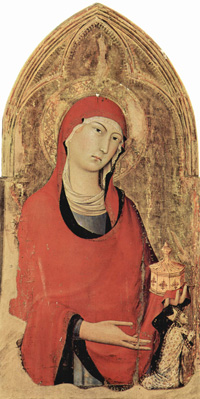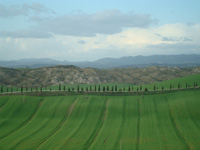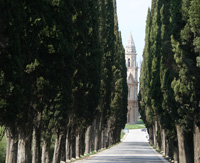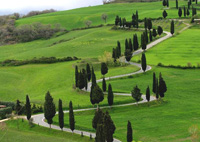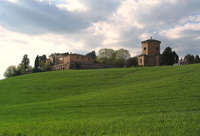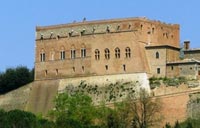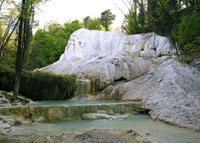| |
|
| |
|
|
|
|
|
|
| |
 |
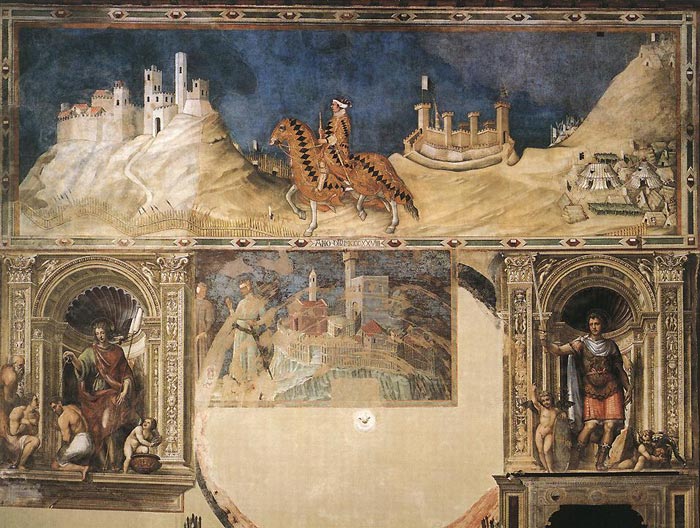 |
| |
Simone Martini, Equestrian portrait of Guidoriccio da Fogliano,1328-30, Palazzo Pubblico, Siena
|
|
 |
 |
| |
|
|
|
| |
|
Simone Martini (1280/85, Siena - 1344, Avignon)
|
|
|
Simone Martini was a major figure in the development of early Italian painting and greatly influenced the development of the International Gothic style. It is thought that Martini was a pupil of Duccio di Buoninsegna, the leading Sienese painter of his time.
His first work was a large fresco of the Maestà (1315, reworked 1321) painted for the Town Hall of Siena as a counterpart to the huge pala by Duccio in the Cathedral. A copy of the work, executed shortly thereafter by Lippo Memmi in San Gimignano, testifies to the enduring influence Simone's prototypes would have on other artists throughout the fourteenth century. The Maestà shows the formative influence of Duccio on Simone Martini, but there is already a perceptible Gothic influence in it which is much strengthened in his next work, the St Louis of Toulouse (1317, Naples). At this date Naples was a French kingdom, ruled by Robert of Anjou, who sent for Simone and commissioned him to paint a new kind of picture: Robert's claim to the throne of Naples was not impeccable, and he therefore caused Simone to paint a large votive image of the newly canonized St Louis of Toulouse (a member of the French Royal house) shown in the act of resigning his crown to Robert.
From this time on, Simone's is essentially a Court art, refined and elegant, and much influenced by France. The type of Madonna evolved by Simone was of great importance in Sienese painting and may be seen in his Pisa polyptych (1320) and in several others. In 1328 Simone painted another fresco for the Town Hall, Siena, this time a commemorative equestrian portrait of the mercenary soldier Guidoriccio da Fogliano.
At some date not yet established Simone went to Assisi and painted a fresco cycle in S. Francesco, of scenes from the life of St. Martin, which again show both the interest in French Gothic art and the sense of chivalric pomp that distinguish Simone. His best-known, and perhaps his finest, work is the Annunciation (1333, Florence, Uffizi) which was painted in collaboration with his brother-in-law Lippo Memmi (d.1357).The inscription on the panel records that Lippo Memmi, whose sister Simone had married in 1324, collaborated on the altarpiece. In its elegance of line and rhythm, the exquisitely rendered details of costume, setting, and flower symbols, and the fragile sentiment of the participants in the sacred event, the Annunciationis a supreme masterpiece in the history of lyrical art.
In 1340-41 Simone went to France. It seems that he went on official business, and not as a painter, to the Curia at Avignon, where the Papacy was then established, and in this Franco-Italian enclave he spent the rest of his life. There he painted the jewel-like Christ Returning to His Parents after disputing with the Doctors (1342, Liverpool), a most unusual subject that perhaps once formed half of a diptych. In Avignon he met Petrarch and became friendly with him, illustrating a Virgil codex for him (Milan, Biblioteca Ambrosiana).
|
|
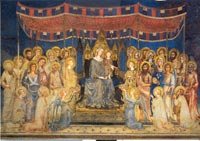
Simone Martini, Maestà, 1315, Palazzo Pubblico, Siena
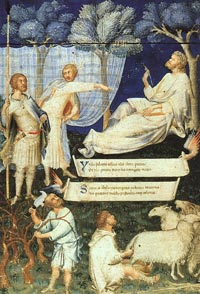
Simone Martini, Petrach's Virgil (title page) (c. 1336), Illuminated manuscript,
Biblioteca Ambrosiana, Milan
|
|
|
|
|
|
|
| |
|
Orvieto
|
|
|
|
|
The style of the work is very much under the influence of the art of Giotto and the overall mood is one of great solemnity. The frontal composition and the use of certain stylistic elements (such as a fairly rigid volumetric construction) that the Pisa Polyptych appeared to have surpassed, suggest that only the figure of the Madonna is actually by Simone.
Originally consisting of seven elements (and while St Peter, Mary Magdalene and St Dominic are all shown in exactly the same pose, St Paul is facing towards the right), this polyptych is now in the Cathedral Museum, although it was painted originally for the church of San Domenico. The painting was commissioned by the Bishop of Sovana, Trasmundo Monaldeschi, the former prior of the Dominican monastery, who paid a hundred gold florins for this altarpiece; he is portrayed in the panel together with Mary Magdalene.
|
|
|
|
|
| |
|
|
|
Simone Martini, Orvieto Polyptych (detail, the panel with Mary Magdalene),
Museo dell'Opera del Duomo, Orvieto |
|
|
|
The two Madonnas in the Siena Pinacoteca, one from Castiglione d'Orcia and the other from Lucignano d'Arbia, are clearly related and must date from more or less the same period. But we have no dates, no signatures and no documents containing any information at all regarding the dating of these works: stylistic analysis is the only element that critics have been able to use. This justifies the widely varying opinions that have been expressed on the subject: some scholars believe that they are totally autograph, while others think that Simone is responsible only for the drawings or for certain sections of the painting, while others still consider them entirely the work of the workshop assistants.
Nonetheless, there are many analogies between the various paintings from this period, such as for example, the features of the Madonna in the San Domenico Polyptych, with her gentle and slightly dreaming eyes, repeated almost exactly in the Madonna in the Orvieto Polyptych; or the lively pose of the Child in the panel from Castiglione d'Orcia which is exactly the same as that of the Child in the Boston painting.
|
|

Madonna and Child (from Castiglione d'Orcia)
|
Next to Duccio di Buoninsegna, Simone Martini stands as the most influential and original painter of the Sienese school. He expanded on the techniques Duccio developed for indicating three-dimensional space with an exquisitely refined use of outline and a vibrancy that does much to enhance the Gothic spirituality which pervades Martini's work.
"Madonna della Misericordia" (Madonna of the Protecting Coat). From the Parish Church of Vertine. Tempera on wood, 154 x 88cm. |
|
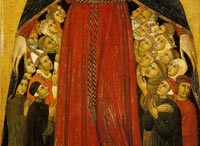 Simone Martini and Lippo Memmi. Madonna della Misericordia, 1308-10. Pinacoteca, Siena Simone Martini and Lippo Memmi. Madonna della Misericordia, 1308-10. Pinacoteca, Siena
|
|
|
|
| |
|
Siena
|
 Simone Martini, Equestrian portrait of Guidoriccio da Fogliano (detail), 1328-30, Palazzo Pubblico, Siena Simone Martini, Equestrian portrait of Guidoriccio da Fogliano (detail), 1328-30, Palazzo Pubblico, Siena
|
After having spent several years in Assisi, Pisa and Orvieto, only occasionally returning to Siena for very brief periods during which he worked in the Palazzo Pubblico, Simone actually returned to Siena on a stable basis. It was during this second Sienese period that Simone painted some of his most famous paintings, such as the Blessed Agostino Novello Altarpiece, the celebrated fresco of Guidoriccio da Fogliano and the Annunciation now in the Uffizi.
The fresco of Guidoriccio da Fogliano, depicting the conquest of the castles of Montemassi and Sassoforte in 1328, formed part of a fresco cycle "Castelli" which occupied the upper part of the wall opposite to the Maestà in the Sala del Mappamondo. It is one of the earliest of such commemorative images, and contains a vast panoramic landscape with the tents of the soldiers in the background. The cycle, commemorating the castles conquered by the Sienese, was initiated in 1314 by the representation of the Castle of Giuncarico, it was continued by the Guidoriccio and in 1331 by the Castles of Arcidosso and Piano. The latter were destroyed in 1361 when Lippo Vanni painted the Battles of Valdichiana and Poggio Imperiale.
In the 1970s, the famous fresco, which had always been, considered the greatest example of Martini's artistic excellence, was re-attributed to a much later artist. The controversy that followed this re-attribution, further stimulated by the discovery of a fresco below the Guidoriccio (a very beautiful one, and certainly much older as we can see from the overlapping of the intonaco), turned into an animated diatribe that has not yet been placated.
The figures in the niches on both sides are the patron saints of Siena, painted by Sodoma, an excellent Sienese master of the sixteenth century.
During restoration work in 1979-80 in the Sala del Mappamondo of the Palazzo Pubblico in Siena, a new fresco was discovered below the imposing Guidoriccio da Fogliano by Simone Martini, representing a castle on a hill and two people in the foreground. The attempt to discover the identity of the unknown author of this work has given rise to much controversy among critics. Duccio, Pietro Lorenzetti, Memmo di Filippuccio, Simone Martini were suggested. The fresco, of outstanding executive quality both in skilful choice of descriptive detail and in its overall coherence, was badly damaged by the Mappamondo, a large, revolving, circular painting by Ambrogio Lorenzetti, which was placed on top of it in 1345.[1]
Art in Tuscany | Guidoriccio da Fogliano in Palazzo Pubblico, Siena
|
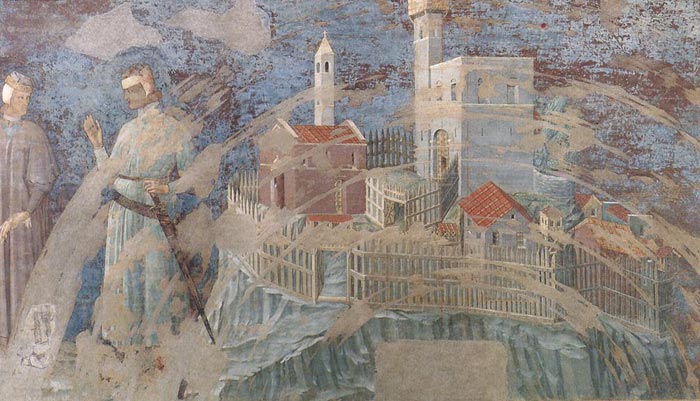 |
| |
Blessed Agostino Novello Altarpiece
|
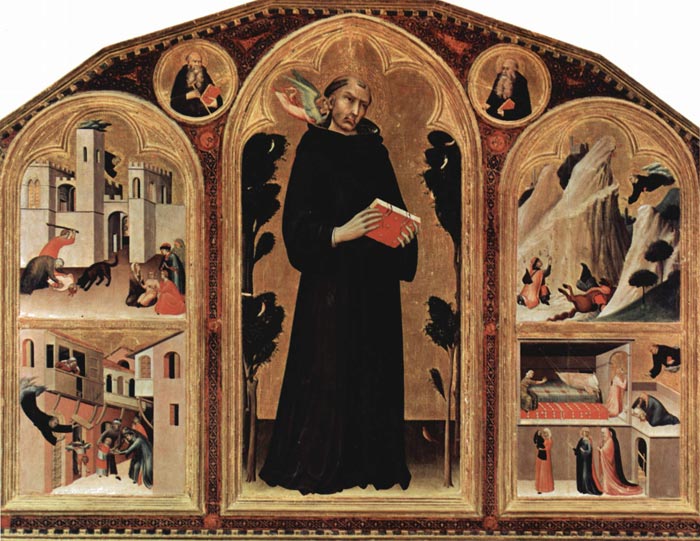 |
Blessed Agostino Novello Altarpiece, 1324, tempera on wood, 198 x 257 cm, Pinacoteca Nazionale, Siena
|
The story of the Blessed Agostino Novello is an example of that form of popular religious spirit that grew up in the towns of Tuscany in the late 13th century and the early 14th. The Church's official saints were considered too remote by the people and spiritually so different from the reality of the times that they could not entirely satisfy the religious fervour that developed in those years. Agostino Novello was one of these figures.
Now in the Pinacoteca in Siena, the painting hung originally in the church of Sant'Agostino, probably above the wooden sarcophagus in which the Blessed Agostino was buried; together with the altar consecrated to him, these two elements formed a burial monument. The dating of this altarpiece can only be approximated. We can only suppose that it was already finished and in place on the occasion of the celebrations in honour of the Blessed Agostino held in 1324 and for which the Commune of Siena allotted a huge sum of money.
The iconography, at least for modern observers like us, is clear but not that simple to understand. The central area, framed by a multifoiled ogival arch, encloses the figure of Agostino, who is given a saint's halo even though he had not been canonized. The wooded landscape, the old hermits in the medallions and the scene of the conversation with the angel (an episode that does not appear in any of the biographies) are all references to the hermit's life he led at San Leonardo al Lago. On the other hand, the face of Agostino, portrayed still as a young man, the red book he carries (perhaps the Constitutiones of the Order, which he had drawn up himself), as well as the fact that the miracles are all taking place in a very realistically described Siena, all suggest Agostino's political commitments and the pastoral duties he performed in the city.
Art in Tuscany | Simone Martini | The Blessed Agostino Novello Altarpiece
|
The Annunciation and the Two Saints
|
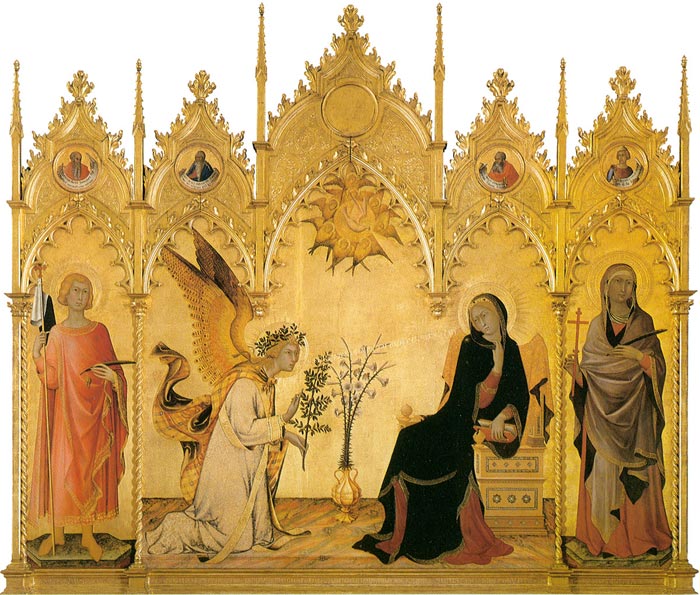 |
Simone Martini, The Annunciation and the Two Saints, 1333, tempera on wood, 265 x 305 cm, Galleria degli Uffizi, Florence
|
By the end of the 14th century, the fusion of Italian and Northern European art had led to the development of an International Gothic style. This style is noted for extreme linearity in painting, this meant flowing curves which gives the effect of elegance and refinement. This beautiful Annunciation was painted around 1333 by Simone Martini and his brother-in-law Lippo Menni for the altar of Sant’Ansano in the Cathedral of Siena. The autograph of the two painters is immortalized in the Latin inscription below
“SYMON MARTINI ET LIPPVS MEMMI DE SENIS ME PINXERVNT ANNO DOMINI MCCCXXXIII”.
The work is considered an absolute masterpiece and one of the greatest examples of Sienese Gothic painting, characterized by the wonderful elegance of both line and color.[2]
Art in Tuscany | Simone Martini | The Annunciation
|
|
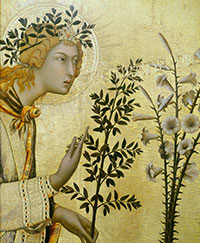
Detail of the Annunciation Angel |
 |
Simone Martine, Madonna and Child between St Stephen and St Ladislaus, 1320-25, fresco, 110 x 200 cm, Lower Church, San Francesco, Assisi
|

Simone Martini's "Guidoriccio da Fogliano": A New Appraisal in the Light of a Recent Technical Examination, Joseph Polzer, Jahrbuch der Berliner Museen, Bd. 25, (1983), pp. 103-141
[1] This fresco is situated below the Guidoriccio and is variously attributed, but convincingly argued to be the real Guidoriccio by Simone.
There is evidence of marks around the face and figure, consistent with damage caused by the throwing of pallets. When the fresco was uncovered, the figure was hidden by a cover of blue paint. Guidoriccio was a mercenary soldier, who changed sides in 1333 and fought for the opposition. It appears far more convincing that the citizens of Sienna would show their disapproval in this way, rather than celebrating a portrait in their town hall of a person who had become their enemy and a traitor to them. The grooves are left by the rotation of the Carte Topa grafica installed in the 15th Century.
At the turn of the century, in a foot note to his volume on fourteenth century Siena, Adolfo Venturi stated that the figure on horse back was not a Simone Martini but was added as a figure to go with the map on the wall below - there are various iconographical disparities which substantiate his claim. Venturi attributed the mappammondo to Abbrogio Lorenzetti. This important observation was not repeated in any subsequent art historical literature GM: "It's one thing to have something published, it's another to have it discussed by future scholars I missed it myself. In 1977 I could have been accused of plagiarism: He saw the same thing."Gordan Moran has been campaigning with his colleague Michael Mallory, since the late seventies, for the reassessment of the Guidorccio da Fogliano fresco in the Plazzo Publico in Siena. He has contested its attribution to Simone Martini (c1284-1344) on many fronts. Despite what appears to be conclusive evidence the art establishment and government of Siena maintain the accepted attribution and have employed many techniques to discredit the findings of Gordon Moran (not stopping at the manipulation of evidence to make their case appear in a better light.) This controversy has added importance because it is holding up the possible discovery of other frescos, in the same room, that would be of the greatest artistic and art historical value. [Heretics 1: The Simone Martini Cover-up]
Art in Tuscany | The Sala del Mappamondo (the World Map Room) and the lost wheel map of Ambrogio Lorenzetti
[2] Source: Annunciation by Simone Martini and Lippo Memmi at Uffizi Gallery | www.uffizi.org
|

Art in Tuscany | Giorgio Vasari's Lives of the Artists | Simone Martini (1285-1344) and Lippo Memmi (d. 1357)
Giovanni Paccagnini, Simone Martini (1955; trans. 1957), is the most complete and dependable monograph on Martini's work. John White, Art and Architecture in Italy, 1250-1400 (1966), is a masterful survey of late medieval Italian art with penetrating critical essays on individual artists. Evelyn Sandberg Vavalà's two works, Uffizi Studies (1948) and Sienese Studies (1953), provide a history of Florentine and Sienese painting based on a close formal analysis of paintings in the principal galleries of the two cities. An old but still useful study is Ferdinand Schevill, Siena: The History of a Mediaeval Commune (1909). |
|
|
|
| |
|

Holiday accomodation in Tuscany | Podere Santa Pia | Artist and writer's residency
|
| |
|
|
|
|
|
Podere Santa Pia |
|
|
|
Val d'Orcia |
| |
|
|
|
|
|
|
|
|
|
| San Biagio, Montepulciano |
|
Famous cyoress road near Montichiello |
|
Monteroni d'Arbia
|
| |
|
|
|
|
|
|
|
|
|
San Giovanni d'Asso |
|
The abbey os Sant'Antimo
|
|
Bagni San Filippo |
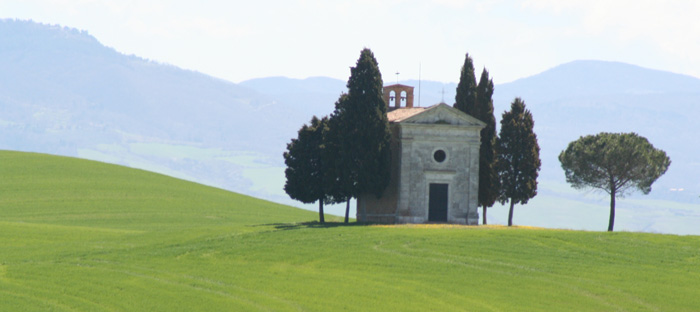 |
| Small chapel, between San Quirio d'Orcia and Pienza |
Vitaleta Chapel near Pienza
Isolated on the rolling hills between Pienza and San Quirico d'Orcia, the Vitaleta chapel and the adjacent farmhouse are easy to miss, even if they are among the most famous icons of Tuscany, as they are standing away from the main road.
Make a walk from Pienza to the Capella di Vitaleta. It is a beautiful way to immerse yourselve in this rolling land of the Val d'Orcia.
Location | The Val d'Orcia
Coordinate: 43°04′15.07″N 11°38′04.54″E
This article incorporates text from Wikipedia and the Encyclopædia Britannica, Eleventh Edition, a publication now in the public domain. |
|
|
| |
|
|
|
| |
|
|
|
| |
|
|
|
| |
|
|
|
| |
|
|
|
| |
|
|
|
![]()
![]()
![]()
![]()





